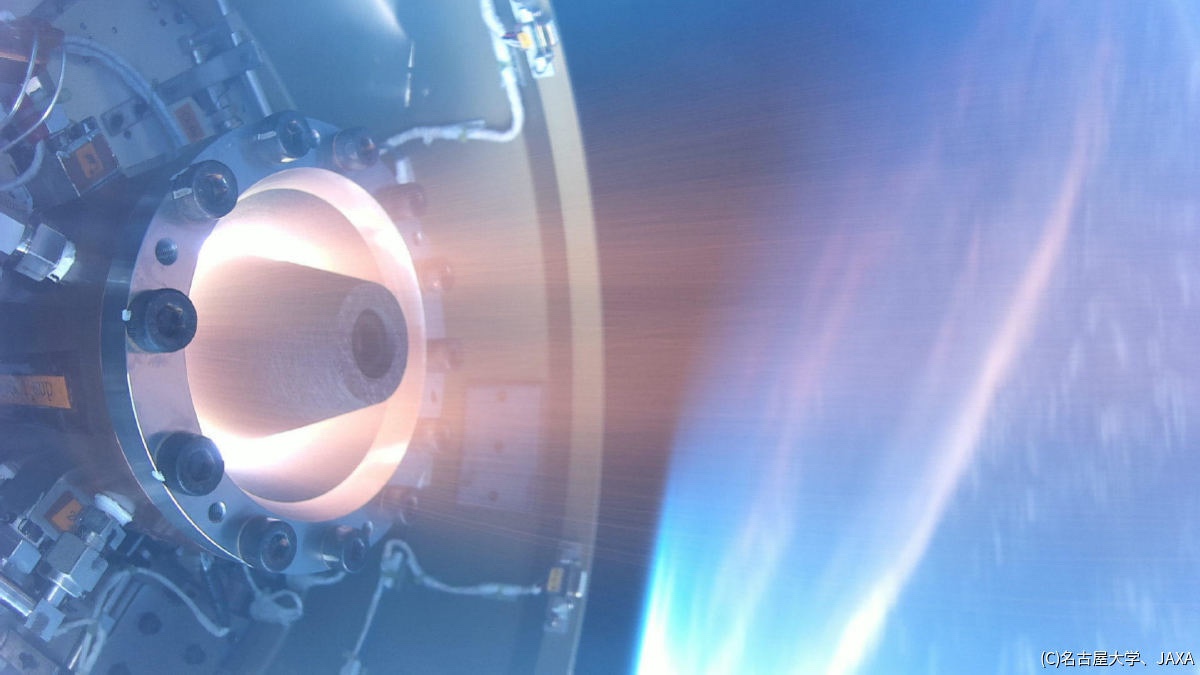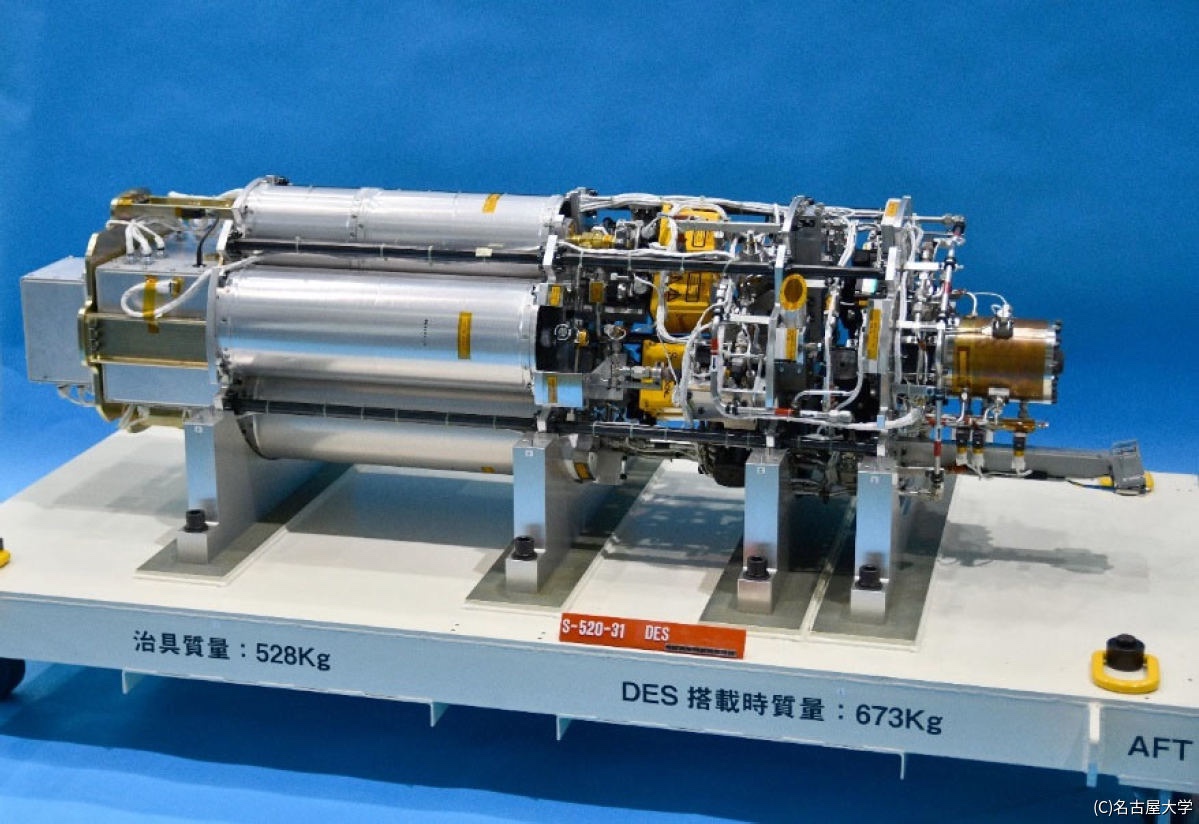

Rotating Detonation Engine: Release of Spaceflight Data!
– Succeeded in space demonstration test of RDE with S-520-31 –
Nagoya University,
Muroran Institute of Technology,
Keio University,
JAXA,
July 27, 2021
Succeeded in the “Space Demonstration Test of Rotating Detonation Engine (RDE)” with space observation rocket S-520-31.
February 27, 2023
RDE is used for the second stage of the sounding rocket S-520-31.
Flight data analysis of space flight demonstration was performed.
Analysis of spaceflight data:
Methane-oxygen propellant was supplied at 182±11 g/s.
The thrust of the RDE is 518N,
Specific impulse is 290±18sec,
The rotational torque was 0.26 N·m.
It also announced that it “confirmed that the engine operation was stable” from the pressure history.
American Institute of Aeronautics and Astronautics (AIAA): SciTech 2022
Details were presented orally at SciTech 2022.
It is summarized in 3 papers in total, 2 in “Journal of Spacecraft and Rocket”.
Detonation is:
A combustion phenomenon in which heat is released by a chemical reaction accompanied by a shock wave.
“The propagation speed is as high as 2 km/s.”
It is possible to “burn combustible gas at high speed”.
The detonation engine is capable of “generating detonation waves and compression waves at extremely high frequencies (1-100 kHz).”
Space Flight Demonstration: Significance of Success
ーThe research team in 2021 succeeds in the space flight demonstration experimentー
kick motor for deep space exploration,
Rocket first and second stage engines, etc.
We have come very close to putting the detonation engine into practical use.
Studies in Europe and America:
-Research is also active in Europe and the United States-
Already, a number of space flight experiment plans following this research have been announced.
BIGLOBE News
https://news.biglobe.ne.jp/it/0228/mnn_230228_9778373148.html
NASA: Successful test of rotating detonation engine
ーDevelopment Plan for “Game-Changing Technology Program”ー
NASA:
I have been researching “rocket engine using rotating detonation (RDRE)”.
Marshall Space Flight Center:
Jointly with IN Space, developed a test engine for RDRE and conducted a combustion test.
The material of this engine is the copper alloy “GRCop-42” developed by NASA.
We used 3D printers and an unconventional design process.
Combustion test carried out:
In 2022, a combustion test will be conducted at the Marshall Space Flight Center.
After repeating the test more than ten times, the maximum thrust reached 17.8 kN and the cumulative combustion time reached about 10 minutes.
TECH+
https://news.mynavi.jp/techplus/article/20230204-2583323/
Japan successfully tests rocket engine propelled by shock waves
https://room.eu.com/news/japan-successfully-tests-rocket-engine-propelled-by-shock-waves
Moteur à détonation rotatif : diffusion des données de vol spatial !
– Réussite au test de démonstration spatiale du RDE avec S-520-31 –
Université de Nagoya,
Institut de technologie de Muroran,
Université de Keio,
JAXA,
27 juillet 2021
A réussi le “Space Demonstration Test of Rotating Detonation Engine (RDE)” avec la fusée d’observation spatiale S-520-31.
27 février 2023
RDE est utilisé pour le deuxième étage de la fusée-sonde S-520-31.
L’analyse des données de vol de démonstration de vol spatial a été effectuée.
Analyse des données de vol spatial :
Le propulseur méthane-oxygène était fourni à 182 ± 11 g / s.
La poussée du RDE est de 518N,
L’impulsion spécifique est de 290 ± 18sec,
Le couple de rotation était de 0,26 N·m.
Il a également annoncé avoir “confirmé que le fonctionnement du moteur était stable” à partir de l’historique de la pression.
Institut américain d’aéronautique et d’astronautique (AIAA): SciTech 2022
Les détails ont été présentés oralement à SciTech 2022.
Il est résumé dans 3 articles au total, 2 dans “Journal of Spacecraft and Rocket”.
La détonation est :
Phénomène de combustion dans lequel de la chaleur est dégagée par une réaction chimique accompagnée d’une onde de choc.
“La vitesse de propagation est aussi élevée que 2 km/s.”
Il est possible de “brûler du gaz combustible à grande vitesse”.
Le moteur à détonation est capable de “générer des ondes de détonation et des ondes de compression à des fréquences extrêmement élevées (1-100 kHz)”.
Démonstration de vol spatial : importance du succès
ーL’équipe de recherche en 2021 réussit l’expérience de démonstration de vol spatialー
moteur de coup de pied pour l’exploration de l’espace lointain,
Moteurs de premier et deuxième étage de fusée, etc.
Nous sommes sur le point de mettre le moteur à détonation en pratique.
Etudes en Europe et en Amérique :
-La recherche est également active en Europe et aux États-Unis-
Déjà, un certain nombre de plans d’expériences de vols spatiaux à la suite de ces recherches ont été annoncés.
Actualités BIGLOBE
NASA : Essai réussi d’un moteur à détonation rotatif
ーPlan de développement pour le “Programme technologique révolutionnaire”ー
Nasa :
J’ai fait des recherches sur “le moteur de fusée utilisant la détonation rotative (RDRE)”.
Centre de vol spatial Marshall :
En collaboration avec IN Space, développement d’un moteur de test pour RDRE et réalisation d’un test de combustion.
Le matériau de ce moteur est l’alliage de cuivre “GRCop-42” développé par la NASA.
Nous avons utilisé des imprimantes 3D et un processus de conception non conventionnel.
Essai de combustion effectué :
En 2022, un test de combustion sera effectué au Marshall Space Flight Center.
Après avoir répété le test plus de dix fois, la poussée maximale a atteint 17,8 kN et le temps de combustion cumulé a atteint environ 10 minutes.
TECH+
Rotating Detonation Engine: Veröffentlichung von Raumfahrtdaten!
– Erfolgreicher Weltraum-Demonstrationstest von RDE mit S-520-31 –
Nagoya-Universität,
Muroranisches Institut für Technologie,
Keio-Universität,
JAXA,
27. Juli 2021
Erfolgreich beim “Space Demonstration Test of Rotating Detonation Engine (RDE)” mit der Weltraumbeobachtungsrakete S-520-31.
27. Februar 2023
RDE wird für die zweite Stufe der Höhenforschungsrakete S-520-31 verwendet.
Es wurde eine Flugdatenanalyse der Weltraumflugdemonstration durchgeführt.
Analyse von Raumfahrtdaten:
Methan-Sauerstoff-Treibmittel wurde mit 182 ± 11 g/s zugeführt.
Der Schub des RDE beträgt 518N,
Spezifischer Impuls ist 290 ± 18 Sekunden,
Das Drehmoment betrug 0,26 N·m.
Es gab auch bekannt, dass es aus der Druckhistorie “bestätigt hat, dass der Motorbetrieb stabil war”.
Amerikanisches Institut für Luft- und Raumfahrt (AIAA): SciTech 2022
Details wurden mündlich auf der SciTech 2022 vorgestellt.
Es ist in insgesamt 3 Artikeln zusammengefasst, 2 im “Journal of Spacecraft and Rocket”.
Detonation ist:
Ein Verbrennungsphänomen, bei dem Wärme durch eine chemische Reaktion freigesetzt wird, die von einer Stoßwelle begleitet wird.
“Die Ausbreitungsgeschwindigkeit beträgt bis zu 2 km/s.”
Es ist möglich, “brennbares Gas mit hoher Geschwindigkeit zu verbrennen”.
Der Detonationsmotor ist in der Lage, “Detonationswellen und Kompressionswellen bei extrem hohen Frequenzen (1-100 kHz) zu erzeugen”.
Raumfahrtdemonstration: Bedeutung des Erfolgs
ーDas Forschungsteam im Jahr 2021 ist erfolgreich im Weltraumflug-Demonstrationsexperimentー
Kick-Motor für die Erforschung des Weltraums,
Raketentriebwerke der ersten und zweiten Stufe usw.
Wir sind der praktischen Anwendung des Detonationstriebwerks sehr nahe gekommen.
Studienaufenthalte in Europa und Amerika:
-Forschung ist auch in Europa und den USA aktiv-
Es wurde bereits eine Reihe von Plänen für Weltraumflugexperimente im Anschluss an diese Forschung angekündigt.
BIGLOBE-Nachrichten
NASA: Erfolgreicher Test des rotierenden Detonationstriebwerks
ーEntwicklungsplan für das „Game-Changing Technology Program“ー
NASA:
Ich habe “Raketentriebwerk mit rotierender Detonation (RDRE)” erforscht.
Marshall Space Flight Center:
Entwickelte gemeinsam mit IN Space einen Testmotor für RDRE und führte einen Verbrennungstest durch.
Das Material dieses Triebwerks ist die von der NASA entwickelte Kupferlegierung „GRCop-42“.
Wir haben 3D-Drucker und einen unkonventionellen Designprozess verwendet.
Verbrennungstest durchgeführt:
2022 wird am Marshall Space Flight Center ein Verbrennungstest durchgeführt.
Nach mehr als zehnmaliger Wiederholung des Tests erreichte der maximale Schub 17,8 kN und die kumulative Brennzeit etwa 10 Minuten.
TECH+